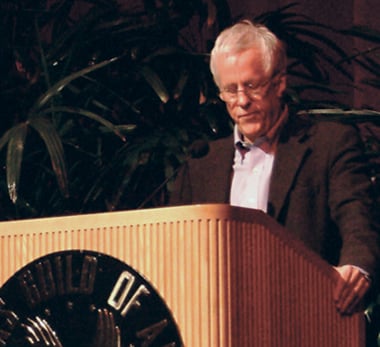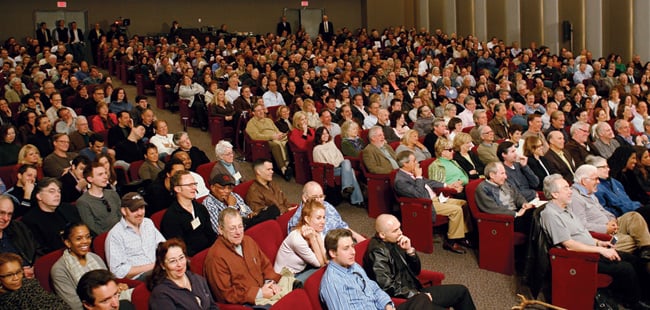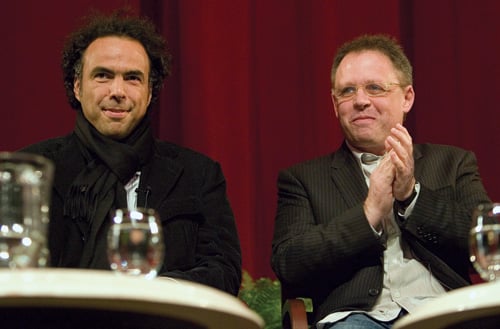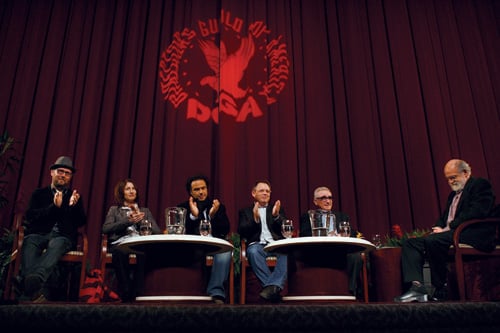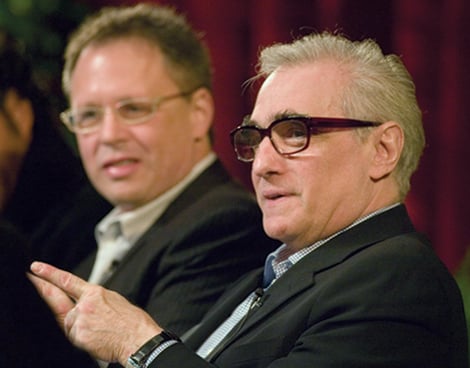Photo above: 2006 Feature Film Nominees Stephen Frears (on monitor via satellite), Jonathan Dayton, Valerie Faris, Alejandro González Iñárritu, Bill Condon, and Martin Scorsese discuss their films with Meet the Nominees: Feature Film Symposium moderator Jeremy Kagan.
The DGA held its sixteenth annual "Meet The Nominees: Feature Film" symposium on Saturday morning, February 3, 2007. Directors Bill Condon (Dreamgirls), Jonathan Dayton and Valerie Faris (Little Miss Sunshine), Alejandro González Iñárritu (Babel) and Martin Scorsese (The Departed) joined moderator/DGA Board Member Jeremy Kagan onstage before a standing room only crowd in the Guild’s Los Angeles Theatre. The fifth nominee, director Stephen Frears (The Queen) also joined the discussion via satellite from London, England.
Kagan opened the conversation with a question about the integral part location plays in both the setting of a film and its actual production. Seven-time DGA Feature Film nominee Scorsese revealed that although his crime drama The Departed was set in Boston, much it was actually filmed in New York.
"We scouted Boston but found that ultimately certain deals were better in New York for the interiors. The bar you just saw is actually the same bar in New York that I've been shooting in for 40 years." A large factor in the decision to shoot off location were the financial incentives New York had to offer. "I'm glad to say that since then—because the film took place in Boston, and Matt Damon being from Boston—the deals have now been reworked to be more amenable to filmmaking. But this was a film about people and their faces. It didn't really matter what places they were in." Scorsese had to recreate several places in order to shoot them the way he wanted. "In the beginning of my career I started out shooting on location because I didn't know any other way and we didn’t have access to a studio. But I must say that sometimes shooting in the studio you have more freedom. You’ve got climate control and you can move the camera as you see fit."
Frears commented on the difficulty of getting royal locations for The Queen. "We never shot in the right place," said Frears. "They would have said no, so we never even bothered to ask. But there really isn't any other place like Buckingham Palace so we did the best we could. Three places in Scotland doubled for Balmoral. Castles in Scotland were hard to find because a lot of them are owned by friends of the queen. But this proved a blessing because it meant that you couldn't use the normal places. Generally if you make a film about The Royalty in Scotland, you'd go to a, b or c. But they wouldn’t have us, so we were forced to look further afield which produced more interesting and original locations."
Condon spoke of how the Superbowl ruined his plans to shoot Dreamgirls in Detroit. "In prep I had these amazing pictures of these bombed-out streets because it was still one of the few inner cities in America that hadn’t come back from the riots of the '60s and the urban decay of the '70s," said Condon. "But when we went to shoot, the Superbowl had come to Detroit and they cleaned it up so it was all gone!” Condon ended up using locations in Los Angeles to double for Motown. "Everything was pretty much shot within a one mile radius of the center of downtown LA. Oddly enough, the one location we had difficulty with was when Deena and Curtis moved to LA. I wanted a house that was a like a huge glass prison he kept her in. But mid-century houses aren’t that big. We finally found a home Frank Sinatra built in Chatsworth that had rooms that were so abstract that we were able to shoot the same room once as the living room, once as the den and once as the bedroom."
Iñárritu recalled one of his most difficult scenes in Babel was in the Moroccan desert where two goat-herding boys shoot at a tourist bus from a mountaintop. "Just to put 300 goats with two kids on a mountaintop is like a nightmare. You'll finish rolling and then it’s like 'Cut! Okay, somebody go get the goats!' Goats don't have word of honor and you can't negotiate with them."
He revealed that his love of Japan influenced his decision to set a section of his film in Tokyo. "It was the perfect place to set the metaphor that something that happens in one place can cause ripples around the world. But I think Tokyo is one of the hardest places in the world for a film director because there is no film commission. It’s almost impossible to shoot anyplace there. We started the scene on the freeway where the father and daughter are having their conversation at 6:00 AM on a Sunday morning when it was almost empty. Ten minutes later the police were chasing us and trying to shut us down for slowing the traffic."
Dayton and Faris instinctively answered the question of how a directing team works, when they looked at each other before Dayton spoke up to respond to Kagan's question about the logistical challenges of Little Miss Sunshine, which takes place largely on a road trip.
“When we were set up they wanted us to shoot in Canada,” said Dayton. “But there’s nothing that looks like the Southwest in Canada,” added Faris. “We wanted this kind of cluttered world, so we found this house in Burbank that was good to go,” said Dayton. “But we needed a house that was big enough to shoot in because we didn’t want to be locked into shots,” Faris continued. “So we found a place that had a lot of openings, like from the dining room to the kitchen so you could get depth in the shots.”
Dayton also revealed that the climatic scene where the family is rushing to arrive at a hotel on time but misses the proper freeway exit had to be shot completely different from how it was originally planned due to municipal difficulties. “We had scouted a place in Long Beach that was perfect, and done all the storyboarding and stunt coordination but the city of Long Beach turned us down at the last minute so we had to rethink that whole sequence. We went up to Ventura to another place we liked and videotaped a loose version of it and sat down with the writer Michael Arndt and worked out a whole different sequence of them being on the wrong off-ramp.”
“We had a half a day to scout it and a half a day to plan this elaborate scene where they get off the freeway and can’t make a left turn,” recalled Faris. “We had this car and five different locations that we had to tie it all together to make it feel like it was one route.”
Throughout the rest of the symposium, Kagan posited more probing questions about the creative process as applied to the pre-production, production and post production phases of each of these excellent films and the directors provided answers that proved as entertaining as they were illuminating. Although the nominees were as different from each other as the various films they created, the morning proved one of camaraderie, friendly competition and a serious exploration into the elements involved in creating a film deemed worthy of one of the industry’s highest honors.

